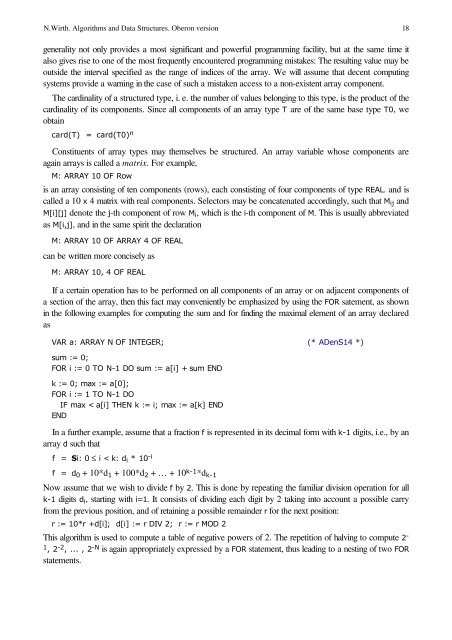Algorithms and Data Structures
Algorithms and Data Structures
Algorithms and Data Structures
Create successful ePaper yourself
Turn your PDF publications into a flip-book with our unique Google optimized e-Paper software.
N.Wirth. <strong>Algorithms</strong> <strong>and</strong> <strong>Data</strong> <strong>Structures</strong>. Oberon version 18<br />
generality not only provides a most significant <strong>and</strong> powerful programming facility, but at the same time it<br />
also gives rise to one of the most frequently encountered programming mistakes: The resulting value may be<br />
outside the interval specified as the range of indices of the array. We will assume that decent computing<br />
systems provide a warning in the case of such a mistaken access to a non-existent array component.<br />
The cardinality of a structured type, i. e. the number of values belonging to this type, is the product of the<br />
cardinality of its components. Since all components of an array type T are of the same base type T0, we<br />
obtain<br />
card(T)<br />
= card(T0) n<br />
Constituents of array types may themselves be structured. An array variable whose components are<br />
again arrays is called a matrix. For example,<br />
M: ARRAY 10 OF Row<br />
is an array consisting of ten components (rows), each constisting of four components of type REAL. <strong>and</strong> is<br />
called a 10 x 4 matrix with real components. Selectors may be concatenated accordingly, such that M ij <strong>and</strong><br />
M[i][j] denote the j-th component of row M i , which is the i-th component of M. This is usually abbreviated<br />
as M[i,j], <strong>and</strong> in the same spirit the declaration<br />
M: ARRAY 10 OF ARRAY 4 OF REAL<br />
can be written more concisely as<br />
M: ARRAY 10, 4 OF REAL<br />
If a certain operation has to be performed on all components of an array or on adjacent components of<br />
a section of the array, then this fact may conveniently be emphasized by using the FOR satement, as shown<br />
in the following examples for computing the sum <strong>and</strong> for finding the maximal element of an array declared<br />
as<br />
VAR a: ARRAY N OF INTEGER; (* ADenS14 *)<br />
sum := 0;<br />
FOR i := 0 TO N-1 DO sum := a[i] + sum END<br />
k := 0; max := a[0];<br />
FOR i := 1 TO N-1 DO<br />
IF max < a[i] THEN k := i; max := a[k] END<br />
END<br />
In a further example, assume that a fraction f is represented in its decimal form with k-1 digits, i.e., by an<br />
array d such that<br />
f = Si: 0 ≤ i < k: d i * 10 -i<br />
f = d 0 + 10*d 1 + 100*d 2 + … + 10 k-1 *d k-1<br />
Now assume that we wish to divide f by 2. This is done by repeating the familiar division operation for all<br />
k-1 digits d i , starting with i=1. It consists of dividing each digit by 2 taking into account a possible carry<br />
from the previous position, <strong>and</strong> of retaining a possible remainder r for the next position:<br />
r := 10*r +d[i]; d[i] := r DIV 2; r := r MOD 2<br />
This algorithm is used to compute a table of negative powers of 2. The repetition of halving to compute 2 -<br />
1 , 2 -2 , ... , 2 -N is again appropriately expressed by a FOR statement, thus leading to a nesting of two FOR<br />
statements.
















